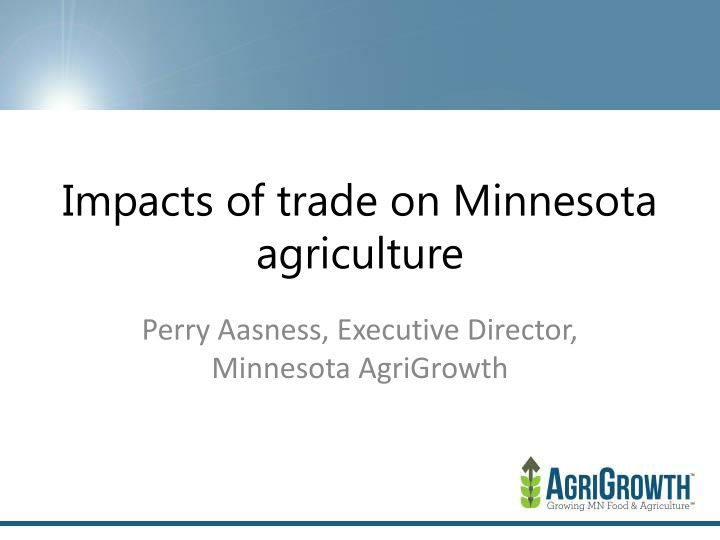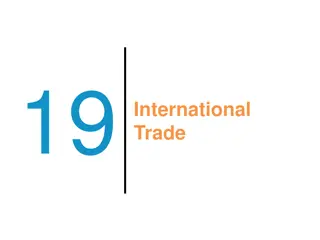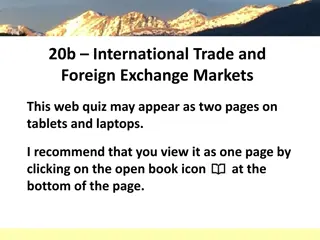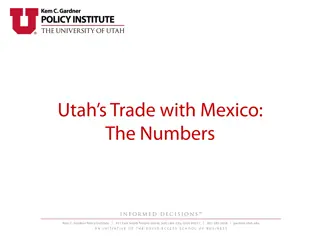Impacts of Trade on Minnesota Agriculture: A Comprehensive Overview
Minnesota's agricultural sector heavily relies on trade, with over one-third of its production being exported. The state is the 4th largest agricultural exporting state in the US, with soybeans, corn, pork, and dairy being top export commodities. Access to export markets is crucial, as demonstrated by the significant rise in agricultural exports over the years. The North American Free Trade Agreement (NAFTA) has played a vital role in boosting Minnesota's trade with Mexico and Canada, resulting in substantial growth in agri-food exports.
Download Presentation

Please find below an Image/Link to download the presentation.
The content on the website is provided AS IS for your information and personal use only. It may not be sold, licensed, or shared on other websites without obtaining consent from the author.If you encounter any issues during the download, it is possible that the publisher has removed the file from their server.
You are allowed to download the files provided on this website for personal or commercial use, subject to the condition that they are used lawfully. All files are the property of their respective owners.
The content on the website is provided AS IS for your information and personal use only. It may not be sold, licensed, or shared on other websites without obtaining consent from the author.
E N D
Presentation Transcript
Impacts of trade on Minnesota agriculture Perry Aasness, Executive Director, Minnesota AgriGrowth
Access to export markets crucial to MN s ag/food sector MN is the 4thlargest agricultural exporting state More than one-third of MN ag production is exported MN s top ag export commodities are soybeans, corn, pork, feed, soybean meal, dairy, wheat *Source, MN Dept of Ag
Minnesota 4thamong states in agriculture exports (source: MDA) Billion $ $22.5 $20.0 $17.5 $15.0 $12.5 $10.0 $7.5 $5.0 $2.5 $0.0
Minnesota Agricultural Export Trend $8.5 $8.0 $7.5 $7.0 $6.5 $6.0 $5.5 Trendline $5.0 $4.5 $4.0 $3.5 $3.0 $2.5 $2.0 $1.5 $1.0 $0.5 $0.0
MN ag exports: #1 among all MN industries (billion $) $8.0 $7.0 $6.0 $5.0 $4.0 $3.0 $2.0 $1.0 $0.0
Minnesota Agricultural Exports: Top Commodities (by value) All other 20% Soybeans 30% Poultry 2% Beef/veal 3% Dairy 3% Wheat 3% Soybean meal 5% Corn 14% Pork 10% Feeds 10%
Minnesota Agricultural Exports: Top Markets China 18% All other 31% Canada 16% Vietnam 2% Philippines 2% Netherlands 2% Mexico 13% Colombia 2% Taiwan 2% S. Korea 4% Japan 8%
NAFTA Negotiated by the George H. W. Bush Administration in 1992; signed into law by Bill Clinton in 1993 Became effective in 1994 Impacts to agriculture: tariffs virtually eliminated for most ag products between the U.S. and Mexico; also reductions and elimination of tariffs on U.S. ag/food exports to Canada In May, 2017, the Trump Administration informed Congress of its intention to engage in negotiations with Canada and Mexico to modernize NAFTA
As a result of NAFTA, Minnesota ag trade with Mexico and Canada has more than tripled Mexico: among the top export markets for U.S. ag commodities: #1 for corn, dairy, pork, soybean meal, poultry and turkey exports Since NAFTA, U.S. dairy exports to Mexico have increased over 500%, #2 for soybeans, beef, processed foods, wheat, barley and DDGs exports Exports to Mexico and Canada accounted for approximately 25% of U.S. beef exports and 50% of U.S. pork exports Sources: MN Dept of Agriculture, Pro Farmer
U.S. Agricultural Exports to Canada Top U.S. ag/food exports to Canada: #1 export market for processed food, wheat products, oats, vegetable oils, biofuels (processed foods account for 61% of all U.S. total ag exports to Canada) Canada is the 2ndlargest importer of U.S. ethanol (25% of total U.S. ethanol exports) #2 in dairy, poultry and turkey #3 in soybean meal #4 in pork # 5 in beef, DDGs Sources: MN Department of Agriculture/Agricultural Marketing Resource Center
Implication for Minnesota agriculture if U.S. withdraws from NAFTA Minnesota ranks 10thamong states in ag exports to Mexico. If pre-NAFTA tariffs were re- imposed by Mexico: 20% tariff on soy flour 20% tariff on soybeans 15% tariff on grains 25% tariff on beef Up to 20% tariff on pork UP to 75% tariff on chicken 45% tariff on cheese Source: Farmers for Free Trade
NAFTA: Current Status U.S., Mexico, and Canada currently in negotiations regarding NAFTA modifications Most recent round conducted in Montreal in January 2018 7thround will be conducted in Mexico City (Feb 25th- March 6th) 8thround will be conducted in Washington DC in April 2018 Key issues for U.S. ag include access to Canada markets for dairy, chicken, turkey, and eggs A modified agreement by the end of 2018? 2019?
Beyond NAFTA - Transpacific Partnership Agreement (TPP) 12-nation pact representing 40% of global GDP and 1/3 of world trade. The U.S. withdrew from the agreement in 2017 A few examples of lost opportunities for U.S. agriculture: Pork: agreement would have reduced tariffs on exports by 80% to Japan and Vietnam Wheat: agreement removed tariff barriers in Vietnam Beef: agreement would have lowered current Japanese tariffs on U.S. beef The remaining 11 TPP member countries expected to sign a deal of their own soon
Final thoughts No trade agreement is perfect, but clearly NAFTA has been a great success for Minnesota s ag/food sector Modernize NAFTA, but serious implications for Minnesota ag/food sector if U.S. withdraws Access to export markets is a key factor in the success and profitability of U.S. (and Minnesota) agriculture. 95% of world population lives outside the U.S. Our competitors aren t waiting around (EU, Brazil, Argentina, etc.) but instead actively seeking bi-lateral and multilateral trade agreements without the U.S.
NAFTA Works Impacts on U.S. Agriculture luncheon March 28th























